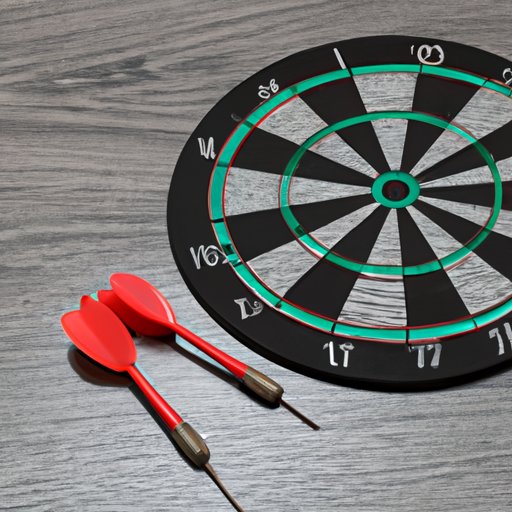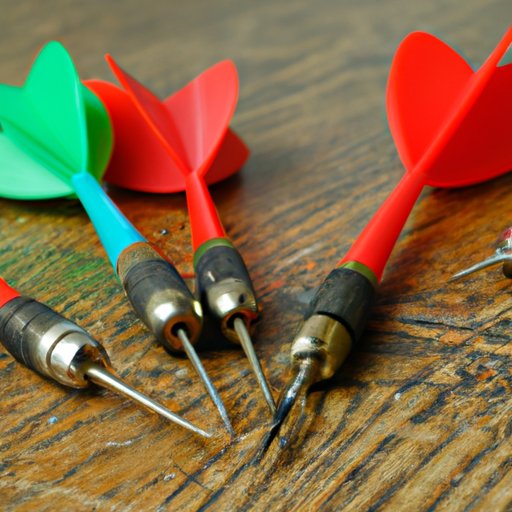
Introduction
Dart throwing is a fun and social activity that can be enjoyed at home or in a bar with friends. However, learning how to throw darts correctly can be challenging for beginners. With the right skills, you can improve your accuracy and make the most out of every throw. This guide will provide you with a step-by-step process for throwing darts, tips and tricks to improve your accuracy, and advice on selecting the right dart set for your skill level.
A Step-by-Step Guide on How to Throw Darts for Beginners
Before getting into the specifics, it’s important to understand the basic mechanics of dart throwing. Holding the dart correctly, stepping to the line, and releasing the dart with precision are all crucial steps in throwing darts successfully.
Grip
When it comes to gripping the dart, there are many different styles and techniques. The most popular grip is the “three-finger” grip, where the dart rests between your thumb, index, and middle finger. The barrel of the dart should sit in the webbing between your thumb and index finger. The choice of which fingers to use is largely down to personal preference. Some people prefer to use only two fingers while others use four. It’s best to experiment and see which one feels the most natural and comfortable.
Body Position
Next, you need to step up to the line with your dominant foot forward (the opposite foot should be back) and shoulders squared. Your arm should be extended behind you while the other arm rests at your side to balance your body. This approach allows for maximum accuracy in your throws. The positioning is also crucial. The dart should be aligned with the center of the board, and your dominant eye should be in line with the target.
Release
To release the dart, you need to aim at the target and extend your arm forward with a fluid motion. The dart will naturally release from your fingers. Keep your arm straight, and your wrist should remain firm throughout the release. After the release, follow through with your arm, keeping your eyes on the target as you do so.

Tips and Tricks for Improving Accuracy in Dart Throwing
Accuracy is the key to successful dart throwing. Here are some tips and tricks to help you improve your accuracy:
Aiming
The most effective way to improve your dart throwing accuracy is by taking the time to aim properly. Focus on the particular area of the board you want to hit and try to visualize the dart hitting the target. It’s also helpful to have a target point on the board that you aim for, like a specific number or color.
Adjusting for Distance
A common mistake beginners make when throwing darts is miscalculating the distance. The closer you stand to the dartboard, the lighter the dart should be. If you’re standing farther from the board, a heavier dart would work better. This is because the weight of the dart affects how much force is required to throw it with accuracy.
Compensating for Errors
Even experienced dart players make mistakes. If you throw the dart and miss the target by a significant amount, adjust your aim for the next turn. If you miss slightly, adjust using your next throw’s power. This technique helps compensate for the error and improve your accuracy over time.
How to Choose the Correct Dart Set for Your Skill Level
Choosing the right dart set is crucial for learning and improving your dart throwing skills. Here are some tips on selecting the proper dart set:
Weight
Dart sets come in different weights, ranging from 12 grams to 50 grams. Beginners should start with a lighter set (16-20 grams) and then gradually move to heavier ones once they feel comfortable.
Material
Dart sets can be made from various materials, including brass, tungsten, or nickel. Tungsten darts are considered to be the best as they provide better balance and control.
Shape
The shape of your dart set is important, as it affects how it flies through the air. For beginners, choose a set with a straight barrel. Straight barrels give the dart better balance while in the air, making it easier to hit your target.
Common Mistakes to Avoid When Throwing Darts and How to Fix Them
Here are some common errors beginners make and how to resolve them:
Adjusting Your Grip
Adjusting your grip is one way to fix errors. If you’re overshooting or undershooting the target, you might need to adjust your grip slightly. Try moving your fingers closer or farther away from the barrel of the dart to see which grip feels more comfortable. Experiment until you find the best grip for you.
Position
If the dart repeatedly lands too low or too high, it may be due to your body position. Adjust your stance to align yourself with the board, and make sure your dominant eye lines up with the particular target.
How to Get the Right Grip on a Dart for Better Throwing
The grip is a crucial aspect of dart throwing. Here are some tips on how to get the best grip:
Comfort
The grip should feel comfortable and natural in your hand. Don’t be afraid to experiment with different grips and finger placements until you find a comfortable position.
Adjusting Your Grip
Adjusting your grip slightly can make a big difference in your accuracy and consistency. We’ve already talked about moving your fingers to adjust the grip, but you can also adjust the angle of the dart to vary the release angle.
The Importance of Stance and Posture When Throwing Darts
Stance and posture are critical to accurate throws of darts. Here’s how to get the stance and posture right:
Stance
Dart players should stand straight, with their dominant foot forward (but not too far), and the other foot behind in a comfortable position. Keep your shoulders aligned and facing the board to ensure a line of sight on the target.
Posture
Good posture is critical to avoid discomfort and to maintain balance and accuracy. Stand tall, with weight distributed equally, and try not to lean forward or backward. Ensure the head is aligned straight to avoid misalignment of the eyesight.
How to Practice Effectively to Improve Your Dart Throwing Skills
The key to getting better at throwing darts is by practicing regularly and effectively. Here’s what to keep in mind:
Frequency
The best way to improve is by practicing often. Even a few throws a day will make a difference. Aim for at least half an hour a day to see a real improvement.
Drills
There are many different drills available to help with dart throwing skills, including follow through, aiming, and accuracy games.
Tracking Progress
Keep track of your progress by logging your scores and analyzing your games. It’s rewarding to see the progress you make over time, and it helps you adjust your practice routine.
Conclusion
Learning how to throw darts accurately requires patience, practice, and a willingness to learn from your mistakes. The steps outlined in this guide will help beginners improve their accuracy and consistency and advance their dart throwing skills. Remember to take your time, breathe deeply, and enjoy the process of learning and improving.




